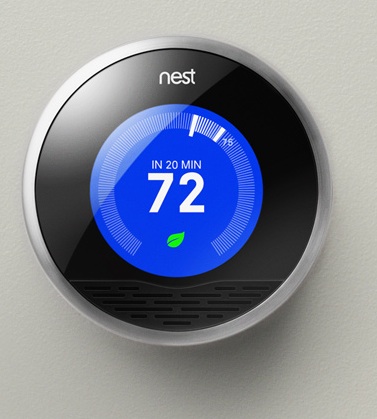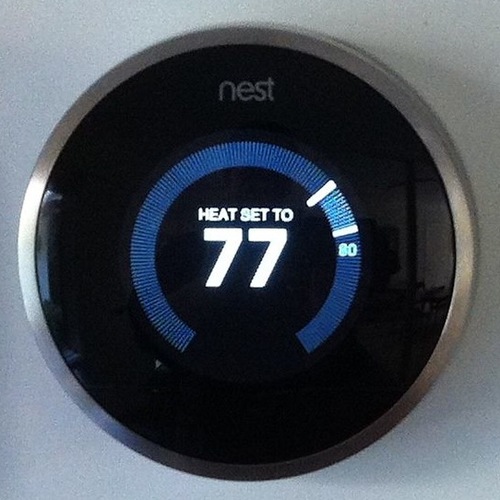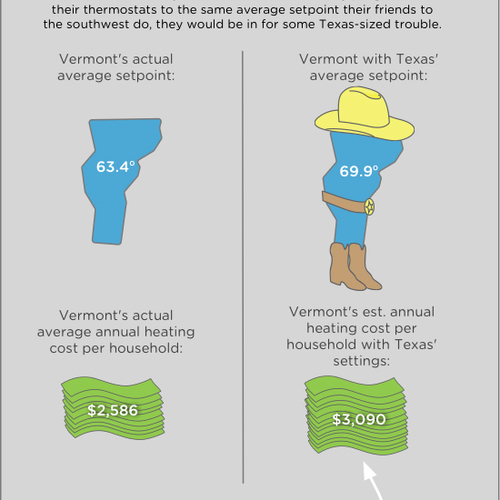Image Credit: Nest Labs (images 1 and 2), Honeywell (image 3), 3M (image 4)
Image Credit: Nest Labs (images 1 and 2), Honeywell (image 3), 3M (image 4) Priced at $250, the Nest is more expensive than most thermostats offered by competitors, but its designers say it can save enough energy to cover the cost of the device in less than 24 months of use. The Honeywell VisionPRO 8000, a programmable thermostat that allows separate programming for each of seven consecutive days. It’s also designed to alert users to system service needs and air filter replacement. The thermostat lists for $200, but is available for about $125. 3M’s Filtrete, a remotely programmable thermostat whose settings can be controlled via Wi-Fi-enabled laptop or smartphone, is available for about $100.
It might seem odd that two former Apple executives who helped lead development of the iPod and iPhone would, upon venturing out on their own, choose to focus on developing a better thermostat. On the other hand, their thermostat – the Nest Learning Thermosat – incorporates a lot the features that Apple’s fan favorites do, including user friendliness; slick, updateable software; modest installation requirements; easy operating instructions; and a simple overall design.
The product was Tony Fadell’s idea. In 2009, Fadell discussed it with engineering expert Matt Rogers. By May 2010, Fadell and Rogers, who both had extensive product-development experience at Apple, had co-founded Nest Labs, based in Palo Alto, California, and focused their attention on making the thermostat as nifty a consumer product as a thermostat can be.
“I loved my job at Apple, and had a great team,” Rogers told the New York Times. “But in essence, we were building toys. At Nest, you can build a product that could have a huge impact on a big problem.”
Teaching a new fixture new tricks
The problem Rogers refers to is, of course, excessive energy use, and the potential positive impact of the Nest Learning Thermostat, which can be ordered for $250 through the company and Best Buy and will begin shipping next month, is tied entirely to how it might help the occupants of a home operate their HVAC system as efficiently and easily as possible.
Many thermostats on the market feature touch screens that offer homeowners plenty of programming options pegged to time and temperature, and many are remotely controllable via computer or smartphone. The Nest thermostat gives users the option to not program the device at all – or at least not in the usual fashion. Rather, as users turn Nest’s simple, circular dial to set the temperature to their liking as each day progresses, the device “learns” the settings. After a week, the thermostat, which also includes a motion sensor that detects when the house is unoccupied, has stored enough data to keep replicating the first week’s operating schedule, which remains constant until the occupants alter the schedule to accommodate a sudden weather change or a change in season.
Nest also indicates, with a green leaf that appears on the dial, when a thermostat adjustment will save energy: lowering the temperature one degree, Nest’s developers say, can reduce energy use about 5%. The company estimates that heeding Nest’s energy-saving indicator and operating an HVAC system on a set schedule can reduce an annual energy bill of $2,200 by about $173 over 12 months.
Seeking favor with consumers
There’s evidence that many consumers are not motivated to diligently track home energy use, no matter how user-friendly the monitoring gadget or detailed its tracking – though the consumers who do use these devices tend to see significant savings. The Nest thermostat requires relatively little sustained attention. The trick will be to convince prospective customers that it is worth spending the $250 on a Nest thermostat when competing devices can be had for half that. Nest Labs is aiming its thermostat at customers who like stylish products – even if it’s a thermostat – and want something that is intuitive, easy to operate, and does most of the learning for them.
Weekly Newsletter
Get building science and energy efficiency advice, plus special offers, in your inbox.















4 Comments
This is interesting
Richard,
In an article I wrote for the October 2003 issue of Energy Design Update, I included the following comment on difficulties encountered by developers of programmable thermostats: "Everyone recognizes that a better solution would be the development of a programmable thermostat so user-friendly that homeowners don’t recoil from the prospect of learning how it works. It remains to be seen, however, whether such a device can be invented."
Perhaps such a device has finally been invented -- we'll see.
Energy Savings
Predicting energy savings for a programmable thermostat is very difficult. The energy savings from thermostat setbacks is real but is only the difference in the Delta T for that time period versus a steady state temperature.
Interesting, but...
Interesting development and I'm all for educating the public, but I wonder if this thermostat can operate the ventilation and humidity of the equipment as well, like an IAQ thermostat. As we all know, it's not only about energy efficiency.
Good point Armando
You are right about having the ability to control whole house systems with one control. I would not be without a programmable thermostat, once programmed there is nothing more to do and they are easily overridden when going away.
Very energy efficient homes will benefit less from a programmable thermostat as they lose or gain heat much more slowly than their business as usual counterparts.
Log in or create an account to post a comment.
Sign up Log in